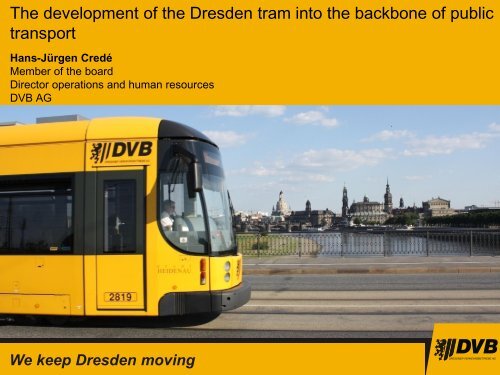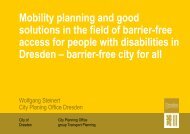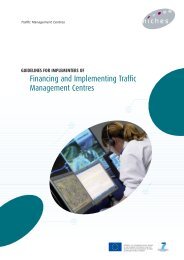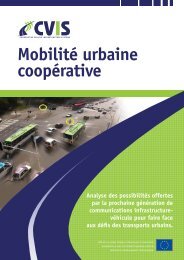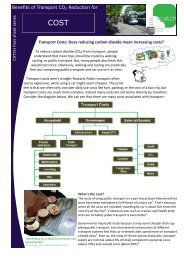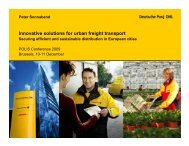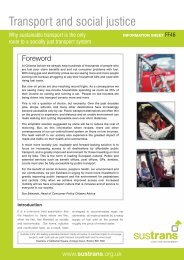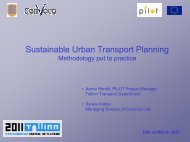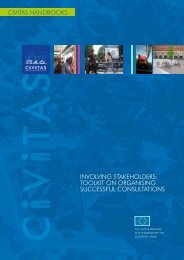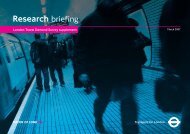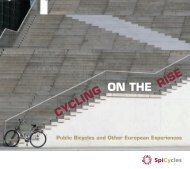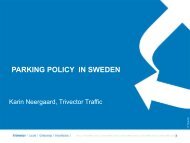Public Transport-The development of the Dresden tram
Public Transport-The development of the Dresden tram
Public Transport-The development of the Dresden tram
Create successful ePaper yourself
Turn your PDF publications into a flip-book with our unique Google optimized e-Paper software.
<strong>The</strong> <strong>development</strong> <strong>of</strong> <strong>the</strong> <strong>Dresden</strong> <strong>tram</strong> into <strong>the</strong> backbone <strong>of</strong> public<br />
transport<br />
Hans-Jürgen Credé<br />
Member <strong>of</strong> <strong>the</strong> board<br />
Director operations and human resources<br />
DVB AG<br />
We keep <strong>Dresden</strong> moving
DVB is <strong>the</strong> main mobility provider in <strong>Dresden</strong><br />
DVB in figures in 2010<br />
Employees<br />
Apprentices<br />
Routes<br />
1 683<br />
150<br />
12 <strong>tram</strong> routes<br />
28 bus routes<br />
4 ferry routes<br />
1 funicular,<br />
1 suspension railway<br />
We keep <strong>Dresden</strong> moving<br />
Fleet<br />
166 light rail vehicles (low floor)<br />
18 Tatra <strong>tram</strong> cars (high floor)<br />
145 buses (low floor)<br />
5 ferry boots, 1 car ferry<br />
4 cable cars<br />
Ridership<br />
passengers p. a. 145.7m<br />
growth compared to last year + 1.2m<br />
Economic data<br />
turnover 100.7m EUR<br />
cost recovery rate 75.0 %<br />
(incl. infrastructure)<br />
loss compensation 39.4m EUR<br />
rides per inhabitant 250<br />
Network<br />
130 km<br />
248 km<br />
2<br />
Passenger<br />
share<br />
71%<br />
29%
<strong>Dresden</strong> can look back on a long, uninterrupted tradition as a „<strong>tram</strong> city“<br />
26.09.1872 Opening <strong>of</strong> <strong>the</strong> first horse drawn <strong>tram</strong> 6.07.1893 First electric <strong>tram</strong> in operation<br />
23.07.1945 <strong>The</strong> <strong>tram</strong> is back in <strong>the</strong> destroyed city centre<br />
We keep <strong>Dresden</strong> moving<br />
3
<strong>The</strong> <strong>Dresden</strong> <strong>tram</strong> system was worn out at <strong>the</strong> time <strong>of</strong> Germany‟s<br />
reunification<br />
We keep <strong>Dresden</strong> moving<br />
4
Service quality was only acceptable for captive-riders<br />
We keep <strong>Dresden</strong> moving<br />
5
<strong>The</strong> 1990s were decisive years for <strong>the</strong> <strong>Dresden</strong> <strong>tram</strong><br />
Bad condition <strong>of</strong> <strong>the</strong> infrastructure<br />
100m € gap in cost coverage p. a.<br />
Cost reduction scenario was<br />
discussed: conversion up to 50%<br />
<strong>of</strong> <strong>the</strong> <strong>tram</strong> network to bus<br />
But <strong>the</strong> <strong>Dresden</strong> public and <strong>the</strong><br />
City <strong>of</strong> <strong>Dresden</strong> expressed <strong>the</strong>ir<br />
support for <strong>the</strong> <strong>Dresden</strong> <strong>tram</strong><br />
Round table discussions resulted<br />
in <strong>the</strong> <strong>Dresden</strong> <strong>Transport</strong> Plan,<br />
passed <strong>the</strong> <strong>Dresden</strong> City Council in<br />
1994<br />
A “pilot line” should show how to<br />
transform a traditional <strong>tram</strong><br />
network into a modern light rail<br />
system<br />
We keep <strong>Dresden</strong> moving<br />
<strong>Dresden</strong> <strong>Transport</strong> Plan 1994:<br />
“<strong>The</strong> <strong>tram</strong> is <strong>the</strong> backbone <strong>of</strong><br />
<strong>the</strong> <strong>Dresden</strong> PT.”<br />
“… stepwise <strong>development</strong><br />
into a light rail system …”<br />
“<strong>The</strong> route Gorbitz – City<br />
centre – Prohlis is initially<br />
intended for a Pilot Scheme<br />
Light Rail.”<br />
6
Modernising a traditional <strong>tram</strong> system into a modern light rail system is a<br />
very complex process<br />
I<br />
Coordination <strong>of</strong> <strong>the</strong><br />
linkage to politics<br />
and public<br />
administration<br />
Determination <strong>of</strong><br />
functions, planning<br />
procedures, and<br />
financing<br />
responsibility<br />
We keep <strong>Dresden</strong> moving<br />
Important fields <strong>of</strong> action<br />
II<br />
Development <strong>of</strong><br />
<strong>tram</strong> infrastructure<br />
As basis for <strong>the</strong><br />
quality <strong>of</strong> network<br />
coverage and <strong>the</strong><br />
product<br />
<strong>development</strong><br />
III<br />
Product<br />
<strong>development</strong> in <strong>the</strong><br />
PT sector<br />
Implementation <strong>of</strong><br />
customer<br />
expectations<br />
regarding to PTquality<br />
and value for<br />
money<br />
7<br />
IV<br />
Restructuring <strong>of</strong> <strong>the</strong><br />
company<br />
Customer-oriented<br />
structure and<br />
process<br />
optimisation<br />
Rationalisation<br />
Change in<br />
corporate culture
I. Changing <strong>of</strong> traditional <strong>tram</strong> systems requires a strong interaction<br />
between <strong>the</strong> spheres <strong>of</strong> politics, administration and <strong>the</strong> company<br />
middle and long term alignment <strong>of</strong><br />
<strong>tram</strong> network <strong>development</strong><br />
complexity <strong>of</strong> track modernisation<br />
within public road space<br />
difficulties concerning political<br />
promotion because realisation is<br />
possible only step by step and<br />
benefits are not known at once<br />
We keep <strong>Dresden</strong> moving<br />
8
Planungskreislauf Linkage between <strong>the</strong> zur spheres Gestaltung <strong>of</strong> politics des and ÖPNV-Angebotes <strong>the</strong> market takes place der DVB in AG<br />
(iterativer communicative Planungsprozess)<br />
planning procedures between <strong>the</strong> City <strong>of</strong> <strong>Dresden</strong> and <strong>the</strong> DVB<br />
Guidelines<br />
City <strong>of</strong> <strong>Dresden</strong><br />
• Urban and traffic planning<br />
authority<br />
• Responsible for <strong>the</strong> streets<br />
• PT authority<br />
• Owner (indirectly through<br />
TWD GmbH<br />
<strong>Transport</strong> political,<br />
Finance political<br />
Environmental political<br />
City planning political<br />
Economical<br />
City council<br />
Planning,<br />
PR,<br />
Promotion<br />
We keep <strong>Dresden</strong> moving<br />
Communicative planning<br />
process:<br />
Analysis<br />
•Costs<br />
•Demand<br />
•Success<br />
Tasks <strong>of</strong> planning:<br />
System design<br />
Network planning<br />
Service planning<br />
Planning <strong>of</strong><br />
Intermodal links<br />
Realisation<br />
Survey<br />
Dresdner Verkehrsbetriebe<br />
• Development <strong>of</strong> markets<br />
• Infrastructure and product-<br />
planning for PT<br />
• Customer communication,<br />
marketing, sales<br />
• PT-operator<br />
• Owner <strong>of</strong> <strong>tram</strong>s, busses,<br />
ferries and cable cars<br />
• Owner <strong>of</strong> <strong>tram</strong><br />
infrastructure<br />
9
<strong>The</strong> PT-company needs to have <strong>the</strong> competence and resources to help<br />
with <strong>the</strong> design <strong>of</strong> <strong>the</strong> changing process for mobility in <strong>the</strong> city<br />
PT<br />
planning<br />
&<br />
market<br />
research<br />
PT management<br />
+ marketing<br />
We keep <strong>Dresden</strong> moving<br />
service design<br />
in PT<br />
DVB<br />
operation<br />
+ maintenance <strong>of</strong><br />
rolling stock<br />
shift planning sales …<br />
PT infrastructure<br />
10
Financing <strong>of</strong> PT is ensured by <strong>the</strong> holding TWD<br />
<strong>The</strong> company is 100% in municipal influence<br />
100 % 100 %<br />
60 %<br />
100 % 100 %<br />
42 %<br />
51 %<br />
40 %<br />
Gesellschaft für<br />
Immobilienwirtschaft<br />
mbH<br />
real estate<br />
property and<br />
management<br />
Energieverbund<br />
<strong>Dresden</strong> GmbH<br />
supply <strong>of</strong> power,<br />
gas, water;<br />
grid operator;<br />
district heating<br />
dd it<br />
<strong>Dresden</strong>-IT<br />
GmbH<br />
information<br />
technology<br />
services<br />
We keep <strong>Dresden</strong> moving<br />
City <strong>of</strong> <strong>Dresden</strong><br />
100 %<br />
Technische Werke <strong>Dresden</strong> GmbH<br />
(TWD)<br />
Dresdner<br />
Verkehrsbetriebe<br />
AG<br />
public transport<br />
provider<br />
TWD<br />
Betriebsgesellschaft<br />
mbH<br />
facility<br />
operator <strong>of</strong><br />
<strong>Dresden</strong><br />
Congress Centre<br />
Directors:<br />
Hans-Jürgen Credé<br />
Reiner Zieschank<br />
N D<br />
Objektgesellschaft<br />
Kongresszentrum<br />
Neue Terrasse<br />
<strong>Dresden</strong> GmbH<br />
owner <strong>of</strong> <strong>Dresden</strong><br />
Congress Centre<br />
11<br />
Stadtreinigung<br />
<strong>Dresden</strong> GmbH<br />
waste<br />
management,<br />
city cleaning
Since DVB is sufficiently financed by TWD it is possible to get fur<strong>the</strong>r<br />
funding for modernising infrastructure<br />
Structure <strong>of</strong> mixed financing for investments:<br />
Federal government<br />
municipality traffic financing law (GVFG)<br />
for projects with more than 50m €<br />
fundings for infrastructure up to 75%<br />
fundings for vehicles up to 50%<br />
Total financing requirements (1 200m Euro)<br />
We keep <strong>Dresden</strong> moving<br />
Saxony<br />
Funds in line with <strong>the</strong><br />
Saxon Investment<br />
Programme (LIP)<br />
Dresdner<br />
Verkehrsbetriebe<br />
financing by<br />
depreciation / holding<br />
12
II. <strong>The</strong> main focus <strong>of</strong> infrastructure <strong>development</strong> was on reconstruction<br />
Ri. Radebeul und Weinböhla<br />
Reconstructed <strong>tram</strong> tracks<br />
Realised extensions<br />
Extensions planned or under construction<br />
Need for action<br />
We keep <strong>Dresden</strong> moving<br />
Tracks with temporary speed restrictions in km<br />
49,0<br />
1990<br />
1991<br />
42,4 39,437,5<br />
1992<br />
1993<br />
30,4<br />
26,3 24,2<br />
1994<br />
1995<br />
18,5<br />
1996<br />
1997<br />
12,8 13,9 11,8 9,8 10,5 9,5 8,7 7,9 9,7 8,6 9,8 10,3<br />
1998<br />
1999<br />
2000<br />
2001<br />
13<br />
2002<br />
2003<br />
2004<br />
2005<br />
2006<br />
2007<br />
2008<br />
2009
A complex measurement was <strong>the</strong> realisation <strong>of</strong> <strong>the</strong> „pilote line“ as a<br />
connection between two large residential areas with <strong>the</strong> city centre<br />
Ri. Radebeul und Weinböhla<br />
Gorbitz<br />
1995 ca. 30 000 inhabitants<br />
2009 ca. 20 000 inhabitants<br />
Existing <strong>tram</strong> network<br />
Extension planned or under construction<br />
Pilot line<br />
City centre<br />
Residential areas Gorbitz, Prohlis<br />
We keep <strong>Dresden</strong> moving<br />
Prohlis<br />
1995 ca. 20 000 inhabitants<br />
2009 ca. 12 000 inhabitants<br />
14
Realisation <strong>of</strong> <strong>the</strong> “pilot line” in partial stages – according to <strong>the</strong> progress <strong>of</strong><br />
<strong>the</strong> joint planning between <strong>the</strong> City <strong>of</strong> <strong>Dresden</strong> and <strong>the</strong> DVB<br />
Accessible stop with year <strong>of</strong> completion<br />
Completed route section<br />
Route section still to be built<br />
We keep <strong>Dresden</strong> moving<br />
15
Financing <strong>of</strong> <strong>the</strong> “pilot line”<br />
Total investment needed for pilot line = 222m EURO<br />
115m EURO 107m EURO<br />
90m EURO 25m EURO<br />
Federal government<br />
municipality traffic financing<br />
law (GVFG) for projects with<br />
more than 50m €<br />
Saxony<br />
We keep <strong>Dresden</strong> moving<br />
Funds in line with <strong>the</strong><br />
Saxon Investment<br />
Programme (LIP)<br />
Dresdner<br />
Verkehrsbetriebe<br />
depreciation / holding<br />
16
<strong>The</strong> „pilot line” gave citizens and politicians an impression <strong>of</strong> what is possible<br />
in an existing <strong>tram</strong> network and should assist in fur<strong>the</strong>r decisions in PT<br />
Combined stop for <strong>tram</strong> and bus<br />
Intermodal stop<br />
We keep <strong>Dresden</strong> moving<br />
Stop with raised carriageway<br />
Customer information<br />
17
<strong>The</strong> positive environmental impact <strong>of</strong> green tracks is helpful for fur<strong>the</strong>r<br />
modernisation <strong>of</strong> infrastructure <strong>of</strong> <strong>the</strong> <strong>tram</strong> system<br />
green tracks in <strong>Dresden</strong> (27 km =<br />
100 000 m² more green for <strong>Dresden</strong>)<br />
improve microclimate in <strong>Dresden</strong><br />
generate oxygen<br />
reduce particular matter<br />
reduce noise emission between 4 to 7<br />
decibel<br />
raise <strong>the</strong> quality <strong>of</strong> life in residential<br />
areas<br />
rain water does not trickle away<br />
it is saved by green tracks via a special<br />
storage layer<br />
as a result <strong>of</strong> this watering is a rare<br />
event<br />
cooling effect <strong>of</strong> green tracks<br />
evaporate approximately 438 litre water<br />
per square meter and year<br />
cooling capability <strong>of</strong> 27 600 000 kWh<br />
We keep <strong>Dresden</strong> moving<br />
18
<strong>The</strong> more difficult conditions for reconstruction <strong>of</strong> <strong>tram</strong> infrastructure<br />
requires innovative solutions and clear political guidelines<br />
We keep <strong>Dresden</strong> moving<br />
prioritisation <strong>of</strong> street space<br />
division<br />
innovative solutions for traffic<br />
organisation and for traffic<br />
facilities<br />
coordination for common<br />
realisation <strong>of</strong> road and <strong>tram</strong><br />
network<br />
19
DVB„s suggestions for network extensions led into a coordinated plan<br />
between <strong>the</strong> City <strong>of</strong> <strong>Dresden</strong> and <strong>the</strong> DVB<br />
Radebeul<br />
trade fair<br />
Nürnberger Str.<br />
Budapester Str./<br />
Chemnitzer Str.<br />
We keep <strong>Dresden</strong> moving<br />
S<br />
S<br />
S<br />
Plauen<br />
S<br />
S<br />
S<br />
Zellescher Weg/<br />
Hp. Strehlen<br />
S<br />
S<br />
Johannstadt<br />
S<br />
S<br />
S<br />
existing <strong>tram</strong>-network<br />
under construction<br />
Extension planned<br />
planed suburban railway stop<br />
20<br />
Weißig
III. Continuous product <strong>development</strong> is important for success in PT<br />
Percentage <strong>of</strong> direct routes: 65%<br />
increasing <strong>the</strong> quality features concerning riding process<br />
Way /<br />
time<br />
to <strong>the</strong><br />
stop<br />
start<br />
High network density<br />
• 12 Tram-lines<br />
• 27 Bus-lines<br />
• 94% <strong>of</strong> all<br />
inhabitants live<br />
within 500 meters to<br />
<strong>the</strong> next stop<br />
100% barrier free access<br />
quality <strong>of</strong> service<br />
every 10<br />
minutes<br />
every 15<br />
minutes<br />
24/7 operation<br />
We keep <strong>Dresden</strong> moving<br />
within<br />
<strong>the</strong><br />
week<br />
at weekend<br />
interchange<br />
modal / intermodal change<br />
connection<br />
control with<br />
OCS<br />
after<br />
8 pm<br />
line speed<br />
stop close to<br />
destination<br />
traffic light<br />
triggering<br />
21<br />
Way / time<br />
to <strong>the</strong><br />
destination
High level <strong>of</strong> service quality intends reliability <strong>of</strong> <strong>the</strong> PT-systems<br />
<strong>The</strong> joint project „North-South corridor“ as part <strong>of</strong> rising reliability<br />
Partners involved:<br />
City <strong>of</strong> <strong>Dresden</strong><br />
Dresdner Verkehrsbetriebe AG<br />
University <strong>of</strong> <strong>Dresden</strong><br />
Objectives:<br />
Holistic traffic optimisation<br />
Prioritisation <strong>of</strong> PT depending on <strong>the</strong> timetable<br />
no priority in case <strong>of</strong> early arrival, high priority in<br />
case <strong>of</strong> delay<br />
Improvement <strong>of</strong> secure connections due to<br />
visualisation and securing connections by means <strong>of</strong><br />
operations control system and traffic lights<br />
Reduction <strong>of</strong> energy consumption and improvement<br />
<strong>of</strong> driving dynamics by means <strong>of</strong> driver assistance<br />
systems<br />
We keep <strong>Dresden</strong> moving<br />
Junction Nürnberger Straße<br />
22
Areas <strong>of</strong> work <strong>of</strong> <strong>the</strong> partners within <strong>the</strong> project „North-South-corridor“<br />
Bus/<strong>tram</strong>way<br />
positioning data<br />
operations<br />
control<br />
system<br />
Current PT<br />
situation<br />
<strong>Public</strong> transport<br />
approaching<br />
modell<br />
<strong>Dresden</strong> University<br />
Multi-modal interface module<br />
<strong>Public</strong> transport<br />
approaching<br />
prognosis<br />
Current road<br />
traffic situation<br />
We keep <strong>Dresden</strong> moving<br />
Priority<br />
decision<br />
system<br />
Time remaining until next green<br />
stage dynamic connection services<br />
Traffic Control<br />
Centre<br />
Traffic<br />
computer<br />
Dresdner Verkehrsbetriebe<br />
Traffic flow<br />
detection<br />
City <strong>of</strong> <strong>Dresden</strong><br />
23<br />
Traffic light<br />
controller
IV. Fur<strong>the</strong>r key aspects <strong>of</strong> modernising <strong>the</strong> public transport system in<br />
<strong>Dresden</strong> had to be realised<br />
implementation <strong>of</strong> transport management and marketing<br />
functions within <strong>the</strong> company<br />
implementation <strong>of</strong> quality management<br />
improvements to services, vehicles and bus/<strong>tram</strong> stops<br />
realising 100% barrier free access<br />
enhancement <strong>of</strong> customer relationship management and<br />
customer information<br />
establishment <strong>of</strong> an integrated transport network (VVO)<br />
one timetable, one tariff, and one ticket independent <strong>of</strong> <strong>the</strong><br />
companies<br />
<strong>the</strong> integration <strong>of</strong> <strong>the</strong> railways, urban transport, and<br />
regional bus transport<br />
consolidation and fur<strong>the</strong>r <strong>development</strong> <strong>of</strong> <strong>the</strong> DVB‟s<br />
computer-aided operations control system (OCS)<br />
interaction <strong>of</strong> DVB‟s OCS among individual companies<br />
in <strong>the</strong> entire VVO (“RBL Oberelbe”)<br />
We keep <strong>Dresden</strong> moving<br />
24
Some results have been achieved<br />
Ridership<br />
Economic data<br />
1991 2009<br />
passengers p. a. 120.0m 145.7m<br />
Customer satisfaction<br />
2000 2009<br />
passengers p. a. 2.94 2.48<br />
1991 2009<br />
cost recovery rate 24.4% 75.0 %<br />
(incl. infrastructure)<br />
loss compensation 100.0m € 39.4m €<br />
We keep <strong>Dresden</strong> moving<br />
135<br />
137 138 137 138 138 138<br />
548 549 550 554 557<br />
548<br />
565<br />
140<br />
25<br />
142 144,5 145,7<br />
574 577 582 582<br />
1999 2000 2001 2002 2003 2004 2005 2006 2007 2008 2009<br />
passengers (mio) inhabitatns in service area (t)<br />
Cost recovery rate in %<br />
(incl. infrastructure)<br />
16,8<br />
1990<br />
69,2<br />
67,0<br />
65,9<br />
63,3<br />
62,0<br />
60,0<br />
56,7<br />
52,6<br />
50,5<br />
48,8<br />
45,0<br />
39,1<br />
33,0<br />
30,2<br />
24,4<br />
1991<br />
1992<br />
1993<br />
1994<br />
1995<br />
1996<br />
1997<br />
1998<br />
1999<br />
2000<br />
2001<br />
2002<br />
2003<br />
2004<br />
2005<br />
73,2 74,274,3 75,0<br />
2006<br />
2007<br />
2008<br />
2009
Impressions <strong>of</strong> modernisation<br />
We keep <strong>Dresden</strong> moving<br />
26
Impressions <strong>of</strong> modernisation<br />
We keep <strong>Dresden</strong> moving<br />
27
Final statement<br />
Only <strong>the</strong> interaction <strong>of</strong> city planning, politics, and PT companies leads to <strong>the</strong><br />
success <strong>of</strong> public transport.<br />
For urban <strong>development</strong> planning <strong>the</strong> existing <strong>tram</strong><br />
networks should be taken into account. <strong>The</strong> companies<br />
must actively accompany <strong>the</strong> process <strong>of</strong> planning.<br />
<strong>The</strong> PT service provider have to be customer-oriented<br />
in structure, processes, and culture.<br />
<strong>The</strong> preservation and expansion <strong>of</strong> public transport infrastructure requires<br />
steady financial accompaniment, <strong>the</strong> protection <strong>the</strong>refore lies in <strong>the</strong><br />
responsibility <strong>of</strong> politics.<br />
We keep <strong>Dresden</strong> moving<br />
<strong>Dresden</strong><br />
<strong>Transport</strong> Plan<br />
2025plus<br />
28
We keep <strong>Dresden</strong> moving<br />
Thank you.


